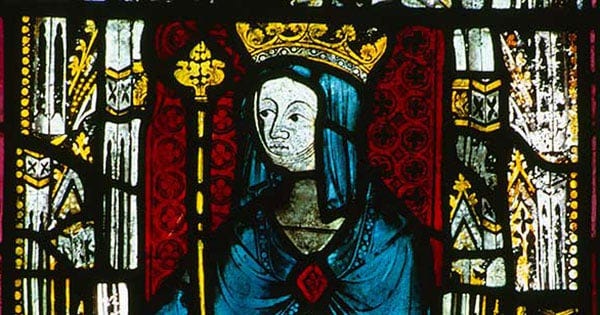Hello, I’m Holly and I write about the untold tales of medieval lives. Subscribe for free to enjoy regular posts from me, including book reviews, short stories, and historical discussions. Or, even better, join our community of like-minded souls to unlock ALL of my content, including an exclusive serialised historical fiction novel, videos and chats, to open up a world of history as you were never taught it. We’d love you to join us…
I recently wrote a short story about the life of an Anglo-Saxon woman, Æthelburh of Kent, whose life was shaped by the actions of the men around her. This story covered just one aspect of her life, her journeys north and south, and I wanted to capture the impact on her of others’ decisions. I wanted to show the real person, the one whose inner thought life had texture and vibrancy, behind the more two-dimensional image we might have when we think of her as merely someone’s wife or sister.
We women are always at the mercy of others.
Please be aware that this story touches very lightly on themes of grief, including the loss of a child. The latter, in particular, is a very brief mention, in Part Two. If these themes are difficult for you, please feel free to skip this post. Part One
Being ‘at the mercy of others’, as I phrased it in that story, was the experience of so many aristocratic women in early Anglo-Saxon England that it’s easy to think that this defined their whole lived experience. That they were no more than pawns in the games played by men. That they were passive individuals, waiting to be directed by the men around them into their roles as wives and mothers.
I think, however, that this focus obscures their own sense of self, their individuality. And it limits our understanding of the variety of experiences that early Anglo-Saxon women had.
These women were real people.
And these real people weren’t always simply married off.
Some of them travelled!
International travel for the benefit of study is not something we necessarily associate with early medieval women.
And yet, a small number of aristocratic women, during the seventh century, were able to travel to and from continental Europe to receive theological and ecclesiastical training.
Bede’s Ecclesiastical History (the major written source for this period, c. A.D. 731) includes the following passage:
Eorcengota [daughter of Eadbald, king of Kent], a child worthy of her parent, was a most virtuous maiden who served the Lord in a monastery founded in the land of the Franks by a noble abbess named Fara in a place called Brie. At that time, because there were not yet many monasteries founded in England, numbers of people from Britain used to enter the monasteries of the Franks or Gauls to practise the monastic life; they also sent their daughters to be taught in them and to be wedded to the heavenly bridegroom. They mostly went to the monasteries at Brie, Chelles, and Andelys-sur-Seine; among these was Sæthryth, stepdaughter of Anna, king of the East Angles … and Æthelburh, his own daughter [not to be confused with Æthelburh of Kent, Eadbald’s sister]. Both of these though foreigners were, by the merit of their virtues, made abbesses of the monastery at Brie.1
We learn here that there were noble women, in the seventh century, who travelled from the Anglo-Saxon kingdoms to enter Continental monasteries, as there weren’t yet many monasteries in England. And some of these women, ‘by the merit of their virtues’ ended up as abbesses in these foreign monasteries.
‘Numbers of people from Britain used to enter the monasteries of the Franks or Gauls’ - and these included women!
Anglo-Saxon England was, at this time of Christianisation, aligning itself more and more to the social and cultural arena of continental Europe. The efforts of the mission of Augustine of Canterbury, sent by Pope Gregory the Great in the closing years of the sixth century, encouraged Anglo-Saxon leaders to adopt a more Roman, Mediterranean, style of politics and material culture.
This included learning from their continental peers about how to ‘do the Christian thing’. Christianity had been the official religion in Britain towards the end of its time as part of the Roman Empire. Following the withdrawal of Roman troops and infrastructure around the year A.D. 410, however, it almost completely vanished from eastern Britain (the areas that would later become the Anglo-Saxon kingdoms). There is very little evidence of any continuity of Christian practice in these areas, so much had to be re-learnt when the Church was re-established under Augustine.
The seventh century was a real boom time for monasticism and it was here that women were afforded the opportunity for international travel. It was fairly common for royal women, particularly princesses and widows, to enter English monastic houses and even rule them. Click the links below to read more about Hild, Æthelburh of Kent, and her daughter Eanflæd, all of whom served as abbesses:

Bede indicates that women who were their peers, Eorcengota and Æthelburh of the East Angles, travelled to the neighbouring kingdom of Francia to learn the trade of monasticism and ended up becoming abbesses of the monastery at Brie. We also know that Hild was supposed to travel to Chelles but instead became part of the monastery at Hartlepool.
How many other women, whose names have been lost to us, are hidden by that phrase, ‘they also sent their daughters to be taught in [continental monasteries]’?
This travel would have opened their eyes to a whole world that they may never have journeyed to otherwise - never have experienced for themselves.
It’s difficult to imagine, in our hyper-connected, globalised world, the monumentality of such a journey in the seventh century. As I write this, I am conscious of my own story, which makes it particularly hard to inhabit the perspective of these women. I was born in the UAE to a British mother and New Zealander father. I went on a plane for the first time at six weeks old and spent my first ten years moving across the Middle East and South East Asia, living in five different countries before moving to the UK in 2004. I travelled more than 40,000 miles per year during my childhood, experiencing vastly different cultures along the way.
I have always taken for granted the privilege of travelling and being a global citizen.
And that’s before adding in the impact that the Internet has had on our connectedness and appreciation for the world around us. I’ve never been to Brazil, for example, but a quick Google search will tell me enough to feel that I know the place without even leaving my home.
So I’m not too sure what it would have been like for a woman who had lived all her life in the same place, with little connection to the outside world beyond word-of-mouth testimony, to arrive in a brand new land having travelled across the sea.
She must have been mindblown!
And given the rate at which ideas travelled back to Anglo-Saxon England, she must have been enthused by what she saw. Monasticism boomed across the Anglo-Saxon kingdoms during the seventh century, for women as well as for men, forged by the international connections these women made and maintained.
They also sent their daughters…
Before we end, it is worth noting briefly the phrasing used by Bede. He says that these women were ‘sent’ by their fathers to the monasteries in Francia. While we have seen that early medieval women were more cosmopolitan than we might instinctively think, they were still constrained by the already-patriarchal structure of society. Unless they were rich widows, women rarely had the agency to orchestrate much on their own. Needless to say, international travel was more often than not beyond their independent means. I am sure, also, that many of them were terrified of the prospect of leaving behind all they’d ever known to make the journey to continental Europe, particularly if this was being done to them rather than arranged with their interest and consent.
This does not mean, however, that international travel did not benefit these women. We do not, unfortunately, have testimonies of their travels in their own words, but it is reasonable to speculate, based on what we know of people today, that many of them will have enjoyed their time abroad: the opportunity to meet new people and experience new cultures may have been a welcome change from the mundanity of life. Given that several of them stayed in Francia to forge impressive careers within the Church, we can assume that they were at least reasonably happy there.
There was more to the female experience than marriage and subjection to the decisions of men (although these were the reality for many women): sometimes it also involved travel to exotic places and an education they could share with others.
I hope you’ve enjoyed this post, seeking to uncover the untold tales of early Anglo-Saxon lives. If you would like to receive regular posts, do consider becoming a free or paid subscriber using the button below.
Telling Their Tales - What's it all about?
Hi there, I’m Holly. Welcome! I’m currently a full-time stay-at-home-mum, having welcomed our little one in May 2023, and I pursue my love for reading and writing history in the edges of motherhood (read: during nap times). Motherhood has changed me entirely in more ways than I have words to describe here, but one of the best is that I’ve been able to sp…
This essay forms part of my contribution to the Sparkle on Substack Essay Club hosted by
. It’s essay 3/24.Bede, Historia Ecclesiastica, III.8. tr. McClure & Collins (1994): 122.












Thank you Holly for the audio version, love these! Insightful to learn that these women "being at the mercy" indeee doesn’t mean they were passive or insignificant but that some of them travelled and developed themselves through discovery and learning!
This is fascinating, and reminded me of my surprise on reading Femina and seeing the map of Margery Kempe's pilgrimage routes. Just went back and found the quote that accompanied it: "the medieval world was not a small, parochial one where everyone lived and died within view of their local church". Thank you for reminding me of this again!